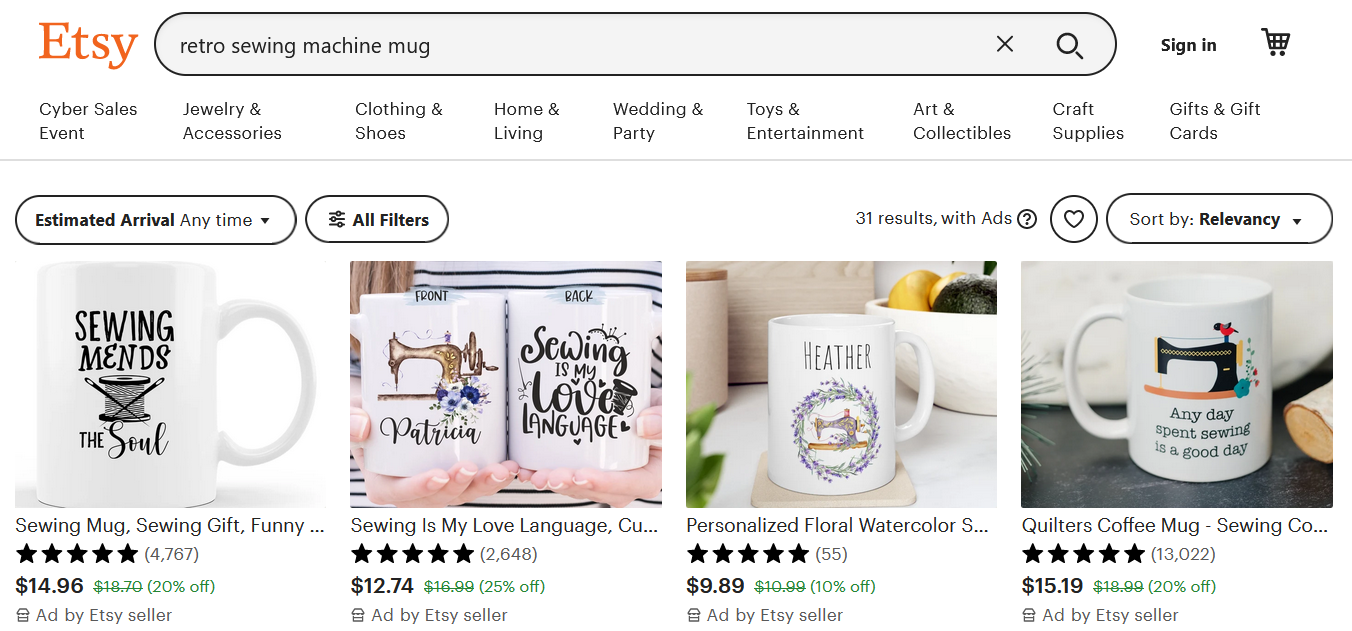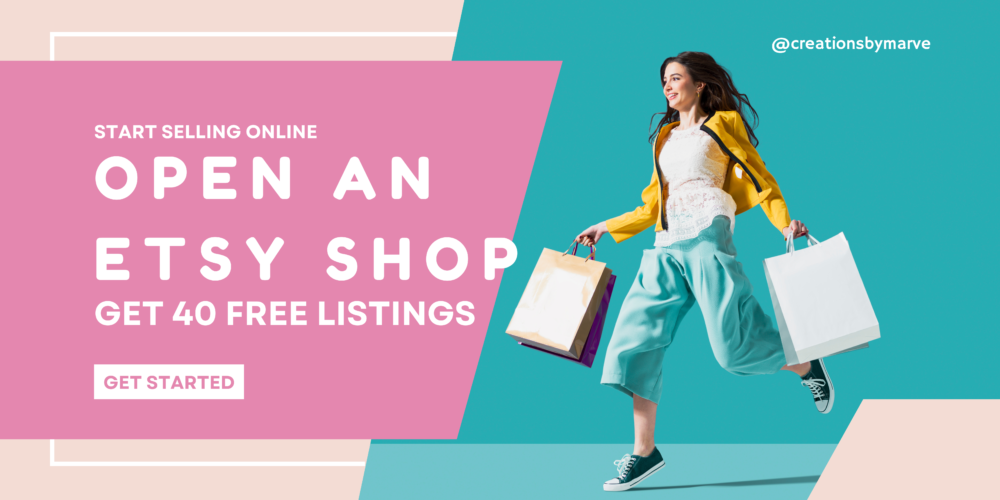If you're new to Etsy (or if you're thinking of opening a shop) you're probably excited about opening and getting those first orders. Creating a banner, choosing keyword rich categories, and making navigation easy for visitors. If so, this tutorial is for you.
This tutorial will show you how to get your Etsy listings seen. You'll learn to SEO optimize your listings that they can be found when potential customers are looking for what you have to offer.
You'll learn how to find the words potential customers will use to search for your items. You'll also learn to do research that helps you find keywords that helps your items be seen by more people.
To be successful on Etsy, you might be surprised to know that the priority and emphasis should be placed on your listings (not your shop) so that they can be seen by as many people as possible.
The reason you want to place the emphasis on your listings is because your listings are what potential customers will see when they are searching for items. Most people searching Etsy will never see your shop.
If you're not on Etsy and you haven't opened a shop yet, you can open your shop and get 40 listings for free. Click the banner below to get started or read our complete tutorial here.
You'll also want to keep reading this article (and maybe bookmark it) to come back to it later) to understand how search works on Etsy, This will give you insight on how to get your listings seen by as many people as possible.
Please Note: Watch the video included in the tutorial to see how you can get 40 free listings. You will need to open and set up a shop directly from the link to ensure that you get your free listings. We have instructions that show you how to set up your shop as well.
What Happens During a Typical Search
Of course every shop owner wants to get as much exposure as possible, but many start out by placing the emphasis on their shop versus optimizing each and every listing. They put a hard work into getting their shops looking great, while neglecting their listings to get as many items in their shop as possible.
To accomplish the goal of increased visibility for your listings, let's think about what happens when someone is looking for something online.
When typical users are looking for an item, one of two things may happen. First, they search Google. Google search results may include Etsy listings. If your listings are found on the first page of Google listings, you increase the chances that they will click on them and make a purchase.
When potential customers search Google for an item that's available on Etsy, they will receive results for Etsy and Google that will show in the search results. There will be shopping options available that will lead to specific listing on Etsy.
The second thing that may happen is that regular Etsy shoppers may skip Google and visit Etsy directly. If so, they will see a page of listings and a search field like the one below. They will enter their search information into the search bar (Image 1)

Image 1
The image above shows what most people see when they visit Etsy to find handmade items. Even if they find your listing on Google, they won't land in your shop. They will land in the listing details of the item they clicked on from Google. And that's why it's so important to optimize your listings pages.
Why It's Important to Do Keyword Research
The biggest benefit to performing keyword research is to ensure that your listings are seen by as many potential customers as possible. Keyword research helps you know which words will bring in the most visitors and therefore giving your business the most potential for sales.
So let's walk through the steps needed to optimize your listings to make sure your they are seen by as many people as possible on Google, as well as Etsy.
The first thing to note is that the search function on Google looks for different things than the Etsy search function. We will be optimizing in this tutorial for Etsy search.
Long Tail Keywords and Why They Make a Difference
And even if you're using a keyword tool, you will still need a starting point. You'll need word groupings (long tail keywords) that potential customers will use when looking for your items. To get the best listing of long tail keywords, it's important to think like your potential customers and the words they would use to find your items.
There are two types of keywords, broad key words and long tail keywords. Long tail keywords are more specific keywords that are sometimes easier to rank for on Google and Etsy.
Long tail keywords get a much smaller number of searches than broad keywords but when someone is searching for those words it can signal that they may have real interest in a specific topic or they are looking for something to buy.
Long-tail keywords are longer and more specific keyword phrases that visitors are more likely to use when they’re closer to a point-of-purchase or when they’re using voice search.
Sometimes this intent can lead to some sort of action, whether it's researching, favoriting your items, putting your items in their cart, and making a purchase.
Long tail keywords got their name from their position on the “search demand” curve.
Even though long tail keywords get fewer searches per month, they are usually less competitive and have lower keyword difficulty. The biggest benefit to using long tail keywords is that it can result in attracting higher quality visitors who are more likely to buy your products.
Why Designing for a Niche is Important
This is another factor that helps to improve the quality of visitors you will bring to your Etsy listings. It's important to pick a niche and design products for that niche, because that will give you additional insight into people who have those common goals, situations, challenges, hobbies, and issues.
Niche keywords are the highly specific long-tail keywords that pertain to a narrow industry. It’s important to optimize your site and your pay-per-click campaigns for niche keywords and not just broad, popular terms, which are often too difficult to rank for, especially as a new venture.
Solutions... Not Just Random Products
Designing for a niche will help you find popular keywords because you're looking at your products through totally different eyes. You're not desigining for random product, you're actually creating solutions.
The solutions you create through your products will help those in your niche reach their goals. Because you've researched your niche, you'll know the lingo (words) they use to describe any issues and you can also use them in your listings.
An Emphasis on Listings Over Shops
Let's say that someone is looking for a gift for a friend that loves to sew. As a shop owner you will want to search Google trends, review industry news, and Etsy's list of top trends for specific items that are doing well on the platform. Use this data to determine what to design and use relevant information with your keywords to determine what is popular. This year we know that retro items are popular based on our research.
Image 2 is an example of the search results for a "retro sewing machine mug". As you can see the search results are showing listings, not shops. So for that reason, most people looking for items will never see your actual shop.
These items are showing at the top of the search results and they stand the biggest chance of being selected as a gift item. You can ensure that your listings are at the top of search results by following the steps below.

Image 2
You can tell which keywords and items are popular on Etsy by using keyword tools like Sale Samurai, Etsy Hunt, Marmalead, eRank and Alura.
How to Get Your Etsy Listings Seen
The table below shows a few examples of keywords that might be used to find the shirt shown in the video exercise.
Broad Keyword
Long Tail Keyword
Christmas t-shirt
Naughty list Christmas shirt for family photos
Holiday shirt
White elephant gift naughty list t-shirt
Christmas gift shirt
Funny Christmas shirt for holiday parties
Family Christmas shirt
Matching family Christmas t-shirts for gatherings
White t-shirt
I'm on the naughty list shopping t-shirt
When Your Shop is Seen by Potential Customers
Though the emphasis should be on your listings, we don't want you to neglect your shop. If you want to start getting results as quickly as possible, it's important to place the emphasis on the part of your shop that has the most visibility.
Optimizing your listings first may help you get results faster than initially placing the focus on your shop. Once you've got a few optimized listings, it's time to make your shop look amazing.
It's important to advertise your shop URL to get people over to take a look.
A great looking, well organized shop (great looking mock ups, niche and keyword optimized categories) makes it easy for potential customers to find your items.
You also need a banner that tells people right away what your shop has to offer. When people stumble across your shop, or they see your listings and want to know something about you, they can find information about your business.
How Etsy Visitors Will See Your Shop
When they use your shop URL. It's important to put your shop URL everywhere, in your marketing materials, on your blog, and social media posts. Be sure to make the distinguish between your shop listings versus your shop URL.
When customers make a purchase. When someone buys a product, you can send them a message, thanking them for for the order and maybe offering them a coupon code to use on their next order.
In your thank you message you can ask them to follow your shop. They can follow you by clicking on the heart icon next to your shop name.
When customers follow your shop, they will be notified when you post new products. They will also be notified when you have a sale or when you update the announcements in your shop.
Place your shop URL in Videos. Make videos telling people what your shop has to offer. Post them on YouTube shorts, Pinterest and TikTok.
Advertise your shop on Social media. Use your shop URL on social media marketing materials with your Shop
Step One: Answer a Few Important Questions
Answer the following questions who, what, when and where:
Step Two: Look at the Design Itself for Keywords
Once you have come up with the answers to the questions in Step One, take a look at the imprint and come up with words that describe various aspects of the design. Look at colors as well as the images and come up with a list of keywords to describe them.
Step Three: Use Previous Answers to Create Keyword Combinations
You want to use what's known as long tail keywords when you are performing your research. Once you have come up with the answers to the questions in Steps One and Two, start putting together different combinations of words that you think potential customers will use to find your products.
Use longer word combinations in your title and descriptions. You have a maximum of 20 characters that you can use for tags, so use the shorter word combinations there.
Step Four: Open Your Keyword Tool and Start Reviewing Data
This is where you'll use your keyword research tool to find out how products like yours are selling on Etsy. This is an optional step, because you should have some really good keyword combinations you can use for your listing titles, tags and description.
You can use the description listed with the product provided in your print provider's catalog and add in your own words and keywords to make it search engine optimized.
Here are the factors to consider when doing your research:
Depending on the item, you may struggle to find keywords that make the most sense for your product. You may need to repeat this process again to find something that has lots of search volume with low competition.
The best scenario would be to use long tail keywords that are words that have a high search volume (SV), high click through rate, low competition on Etsy and low search volume on Etsy and Google.
Try one or more of these methods out, and if needed tweak t to meet your needs. The more you practice with it, the easier it will be to find winning keywords. Let me know if yo have any questions.
Recommended Tech Stack
Themes and Site Builders
This a list of the WordPress site builders we recommend.
Email Marketing Providers
Email marketing is a critical business building function. Here are our recommended resources.
Payment Processors
Don't have a shop? Create links that will enable you to get paid.



